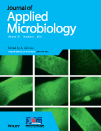Ver ítem
- xmlui.general.dspace_homeCentros Regionales y EEAsCentro Regional CórdobaEEA Marcos JuárezArtículos científicosxmlui.ArtifactBrowser.ItemViewer.trail
- Inicio
- Centros Regionales y EEAs
- Centro Regional Córdoba
- EEA Marcos Juárez
- Artículos científicos
- Ver ítem
Evaluating the impact of the biocontrol agent Trichoderma harzianum ITEM 3636 on indigenous microbial communities from field soils
Resumen
Aim: to investigate the impact of inoculating peanut seeds with the biocontrol agent Trichoderma harzianum ITEM 3636 on the structure of bacterial and fungal communities from agricultural soils.
Methods and Results: PCR‐Denaturing gradient gel electrophoresis (PCR‐DGGE) and next‐generation sequencing (NGS) of amplicons (or marker gene amplification metagenomics) were performed to investigate potential changes in the structure of microbial communities
[ver mas...]
Aim: to investigate the impact of inoculating peanut seeds with the biocontrol agent Trichoderma harzianum ITEM 3636 on the structure of bacterial and fungal communities from agricultural soils.
Methods and Results: PCR‐Denaturing gradient gel electrophoresis (PCR‐DGGE) and next‐generation sequencing (NGS) of amplicons (or marker gene amplification metagenomics) were performed to investigate potential changes in the structure of microbial communities from fields located in a peanut‐producing area in the province of Córdoba, Argentina. Fields had history of peanut smut (caused by Thecaphora frezii) incidence. The Shannon indexes (H’), which estimate diversity, obtained from the PCR‐DGGE assays did not show significant differences neither for bacterial nor for fungal communities between control and inoculation treatments. On the other hand, the number of Operational Taxonomic Units (OTUs) obtained after NGS was similar between all the analyzed samples. Moreover, results of alpha and beta diversity showed that there were no significant variations between the relative abundances of the most representative bacterial and fungal phyla and genera, in both fields.
Conclusions: T. harzianum ITEM 3636 decreases the incidence and severity of agriculturally relevant diseases without causing significant changes in the microbial communities of agricultural soils.
[Cerrar]

Autor
Ganuza, Mauricio Roque;
Pastor, Nicolás A.;
Boccolini, Monica Fabiola;
Erazo, Jessica Gabriela;
Palacios, S.;
Oddino, Claudio;
Reynoso, María Marta;
Rovera, Marisa;
Torres, Adriana Mabel;
Fuente
Journal of Applied Microbiology First published: 01 November 2018
Fecha
2018-11
Editorial
Wiley
ISSN
1364-5072
1365-2672
1365-2672
Formato
pdf
Tipo de documento
artículo
Palabras Claves
Derechos de acceso
Abierto
 Excepto donde se diga explicitamente, este item se publica bajo la siguiente descripción: Creative Commons Attribution-NonCommercial-ShareAlike 2.5 Unported (CC BY-NC-SA 2.5)
Excepto donde se diga explicitamente, este item se publica bajo la siguiente descripción: Creative Commons Attribution-NonCommercial-ShareAlike 2.5 Unported (CC BY-NC-SA 2.5)


